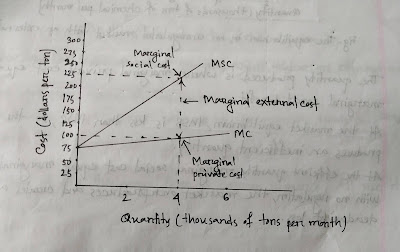The marginal social cost is recognized as the marginal cost incurred by the entire society - by the producer and by everyone else on whom the cost falls. The Marginal social cost is the sum of marginal private cost and marginal external cost. That means MSC = MC + Marginal external cost. Marginal private cost, marginal external cost, and marginal social cost expand with output. The marginal external cost is termed as the vertical distance between the MC and MSC curves in Figure-1.  Figure-2: Environmental Economics-Part A-Lecture 2-Sub Lecture 2A-Equilibrium in an unregulated market with an external cost-ageconbd.blogspot.com The quantity produced is ensured where marginal private cost equals marginal social benefit.
|
Ticker
6/recent/ticker-posts
Environmental Economics-Part A-Lecture 2-Sub Lecture 2A
MD. SAJJAD HOSSEN
July 15, 2020
You may like these posts
Catagories
- _175
- -195
- 3-2
- 3-2 all course pdf
- Agricultural Economics
- Agricultural Economics Quiz Test
- Agricultural Finance pdf
- Agricultural Price Analysis
- BCS
- Chemistry
- DEPS 377
- Display ads
- English
- Environmental Economics
- Environmental Economics Part A
- Environmental Economics-Part A
- Environmental Economics-Part B
- eprothomalo
- eprothomalo-03.09.2020
- Financial Express Epaper
- Gift for Bangladesh
- Global
- Google Adsense
- HSC College Admission Website Link
- In-article ads
- Literature
- More
- News
- Online Assignment
- Online Class
- Online Class Summary
- Paypal Gift Card
- pdf add to blogger
- Poem
- Principle of Agricultural Economics
- Research Assignment
- SME
- SME-Part A
- SME-Part B
- University
- Xoinworkers
Popular Posts

Principle of Agricultural Economics
September 03, 2020
Tags
- 3-2
- SME
- SME-Part B
- SME-Part A
- Environmental Economics
- Agricultural Price Analysis
- Google Adsense
- Agricultural Economics
- DEPS 377
- Environmental Economics Part A
- More
- News
- Online Assignment
- eprothomalo
- -195
- 3-2 all course pdf
- Agricultural Economics Quiz Test
- Agricultural Finance pdf
- BCS
- Chemistry
- Display ads
- English
- Environmental Economics-Part A
- Environmental Economics-Part B
- Financial Express Epaper
- Gift for Bangladesh
- Global
- HSC College Admission Website Link
- In-article ads
- Literature
- Online Class
- Online Class Summary
- Paypal Gift Card
- Poem
- Principle of Agricultural Economics
- Research Assignment
- University
- Xoinworkers
- _175
- eprothomalo-03.09.2020
- pdf add to blogger
Random Posts
3/random/post-list
Recent in Environmental Economics
3/Environmental Economics/post-list
Popular Posts

Chemistry 2nd Paper Product 1
September 12, 2020

Agricultural Economics Admission Info
June 23, 2020

Environmental Economics-Part B-Lecture 1
July 10, 2020
Menu Footer Widget
Crafted with by TemplatesYard | Distributed by Gooyaabi Templates
Copyright 2020 agecon All Right Reseved






0 Comments